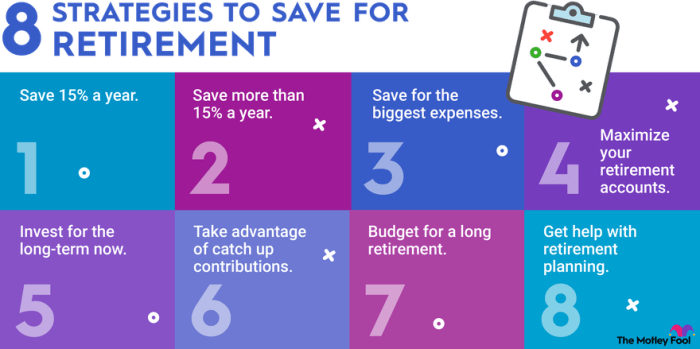Get ready to dive into the world of retirement funds strategies! From traditional to Roth options, maximizing contributions to employer matches, this guide will equip you with the knowledge needed to secure your financial future. Let’s roll!
Overview of Retirement Funds Strategies
Planning for retirement is crucial to ensure financial stability in your later years. Having a well-thought-out retirement funds strategy can help you achieve your retirement goals and maintain your desired lifestyle.
Types of Retirement Funds
- 401(k): A retirement savings plan sponsored by an employer that allows employees to contribute a portion of their salary on a tax-deferred basis.
- IRA (Individual Retirement Account): A personal retirement account that offers tax advantages for individuals to save for retirement.
- Pension Plans: Defined benefit plans provided by employers that pay out a set amount to employees upon retirement.
Diversifying your retirement funds across multiple strategies can provide several benefits, including spreading risk, maximizing tax advantages, and ensuring a more secure financial future. By utilizing a combination of different retirement funds, you can create a well-rounded portfolio that suits your individual needs and preferences.
Traditional vs. Roth Retirement Funds
When it comes to retirement planning, one of the key decisions you’ll need to make is whether to invest in a traditional or Roth retirement fund. Each option comes with its own set of advantages and considerations, particularly when it comes to tax implications.
Traditional retirement funds allow you to contribute pre-tax dollars, which can help lower your taxable income for the year. However, when you withdraw funds during retirement, you’ll pay taxes on both your contributions and any investment growth. On the other hand, Roth retirement funds are funded with after-tax dollars, meaning you won’t get a tax break on your contributions. However, when you withdraw funds in retirement, both your contributions and any investment growth can be withdrawn tax-free.
Tax Implications
- Traditional retirement funds offer immediate tax benefits by reducing taxable income.
- Roth retirement funds provide tax-free withdrawals in retirement, which can be advantageous if you anticipate being in a higher tax bracket later in life.
- Consider your current tax situation and future tax expectations when deciding between traditional and Roth retirement funds.
Scenarios for Consideration
- If you are in a lower tax bracket now and expect to be in a higher tax bracket in retirement, a Roth retirement fund may be more beneficial.
- Conversely, if you are in a higher tax bracket now and anticipate being in a lower tax bracket in retirement, a traditional retirement fund could be the better choice.
- Individual circumstances, such as income level, retirement goals, and tax considerations, will ultimately determine which type of retirement fund is most suitable for you.
Investment Options within Retirement Funds

When it comes to retirement funds, there are various investment options available to help grow your savings over time. These options typically include stocks, bonds, mutual funds, and other financial instruments.
Risk Tolerance and Investment Choices
Understanding your risk tolerance is crucial when deciding where to invest your retirement funds. Risk tolerance refers to your ability and willingness to withstand fluctuations in the value of your investments. Factors such as age, financial goals, and investment timeline can all influence your risk tolerance.
- Stocks: Investing in stocks can offer high returns but also comes with higher levels of risk due to market volatility. It’s important to diversify your stock portfolio to mitigate risk.
- Bonds: Bonds are considered safer investments compared to stocks as they offer a fixed income stream. They are typically less volatile but may have lower returns.
- Mutual Funds: Mutual funds pool money from multiple investors to invest in a diversified portfolio of stocks, bonds, or other securities. They offer a good balance of risk and return, making them a popular choice for retirement funds.
Remember, the key is to find the right balance between risk and return that aligns with your risk tolerance and financial goals.
Maximizing Contributions and Employer Matches
When it comes to retirement funds, maximizing your contributions is key to building a solid financial future. By contributing the maximum amount allowed by law each year, you can take advantage of tax benefits and grow your savings over time. Additionally, taking full advantage of employer matches can significantly boost your retirement fund balance.
Maximizing Contributions
- Contribute the maximum amount allowed: Make sure to contribute the maximum amount allowed by law each year to your retirement fund. This will help you take full advantage of tax benefits and grow your savings faster.
- Automate your contributions: Set up automatic contributions from your paycheck to ensure that you never miss a contribution. This can help you stay on track with your savings goals.
- Catch-up contributions: If you are over 50 years old, you can make catch-up contributions to your retirement fund. Take advantage of this opportunity to boost your savings in the years leading up to retirement.
Employer Matches
Employer matches are contributions that your employer makes to your retirement fund based on your own contributions. Taking full advantage of employer matches can significantly increase your retirement savings over time.
- Understand your employer’s match: Make sure you understand how much your employer is willing to match your contributions. Contribute at least enough to maximize this match to make the most of this benefit.
- Contribute consistently: Consistently contributing to your retirement fund, especially when it means receiving employer matches, can have a long-term impact on your retirement savings. It’s important to stay committed to your savings goals.
- Take advantage of vesting: Some employer matches may be subject to vesting schedules. Make sure you understand these schedules so you can maximize your employer matches effectively.
